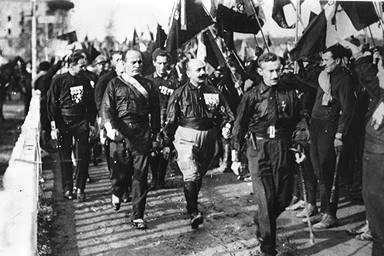Life in Fascist Italy
The dictatorship in Mussolini’s Italy between 1918 and 1939 was all-encompassing. The state controlled people’s lives at every level, from their work to their personal life, finance and housing.
The dictatorship Mussolini had created in Italy between 1918 and 1939 sought control over every aspect of people’s lives, from work to finance, religion and property. Those individuals who attempted to shy away from the state control were punished, and the threat of such punishment was usually enough to prevent this behaviour. Every Italian was expected to abide by the rules set out by Mussolini and his Fascist Party. The Blackshirts - the Fasci di Combattimenti, or police force – enforced these rules and ensured everyone was toeing the line. Indeed, those that publicly went against the rules were singled out and made into a statement, such as the murder of the socialist Mussolini critic, Matteotti.
While in the same vein as Germany’s SS, the Blackshirts did not have quite such a formidable reputation, although they did strike fear into the Italians. Mussolini made clear his thoughts on those that stepped out of line, saying: “Italy wants peace and quiet, work and calm. I will give these things with love if possible and with force if necessary.” There was also a secret police force in Italy, the OVRA, which was created in 1927 and headed up by Arturo Bocchini. While the OVRA did arrest around 4,000 Italians over the years up to 1940, this was nowhere near the number arrested by Germany’s equivalent SS and Gestapo. Instead of facing possible punishment, many Italians who did not share political beliefs with Mussolini moved away.

Education was another major issue that was wrangled over in Italy as Mussolini fought to control it. He saw youths as potential future members of his Fascist party and therefore was extremely interested in the school curriculum and youth organisations across the country. He desired boys to become soldiers and girls to become mothers, to offer Italy a new generation of Fascists. In Germany, Hitler was following the same way of thinking, planning for the future of the Nazi Party and the country as a whole.
The Italian curriculum taught school children that modern Italy began in 1922 following the famous March on Rome, while Mussolini was described as the person to turn Italy into the European superpower it was always destined to be. Boys were encouraged to attend youth movements, including ones called Balilla, Sons of the She Wolf and Avanguardista and it was here that they learned that fighting was a ‘natural’ male desire. Indeed, the Fascist slogan “War is to the male what childbearing is to the female,” was frequently uttered at the meetings of these organisations. Another slogan the boys were very familiar with was, “I believe in Rome, the Eternal, the mother of my country……I believe in the genius of Mussolini…and in the resurrection of the Empire.”
The role of women in Fascist Italy was modelled on that of Hitler’s Germany, in that they were destined to be married and bear a large number of children that would then be raised in the Fascist way. Indeed, Mussolini showcased this desire with his 1927 Battle for Births, a move which was based on his belief that the population of his country was too small to be a European superpower. Italian families would ideally have five children, Mussolini said, and tax breaks were rolled out to encourage this, with large families gaining additional benefits.
In his ideal world, Mussolini dreamed of a population topping 60 million by 1950, a huge increase from the 37 million that was reality in 1920. His 1927 bid to achieve this through the Battle for Births did not, however, go to plan. While the number of people did indeed increase as planned, as medical care had improved, people were living longer and this led to a declining birth rate between the years of 1927 and 1934.
See also: The Economy in Fascist Italy
MLA Citation/Reference
"Life in Fascist Italy". HistoryLearning.com. 2026. Web.
